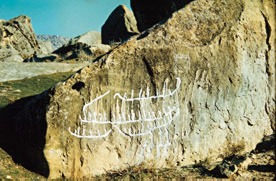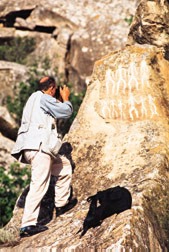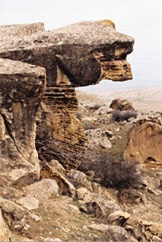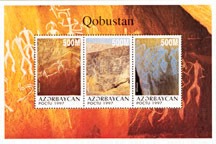|
Summer 1998 (6.2) Gobustan by Nigar Abbaszade
When I was just a kid in high school, our ancient history teacher took us to see the Stone Age petroglyphs at Gobustan. It wasn't far away-only 54 km southwest of Baku. I was amazed by the carvings I saw there-ancient peoples, goats, deer, boats and hunting scenes. The images made a deep impression on me and led me to do historical research about the "Magical Images in Ancient Art in Azerbaijan" for my Bachelor's degree at Baku State University in the Department of Culture and Art. Discovery of Gobustan In 1939, archeologist Isaak Jafarzade began the first archeological investigation of the petroglyphs at Gobustan. Between 1940 to 1965, teams identified and documented approximately 3,500 individual rock paintings on 750 rocks. The most ancient petroglyphs have been identified as belonging to the 12-8th century B.C. However, it is assumed that life existed here even earlier and that Gobustan was one of the cradles of civilization. This research was published in a book entitled "Gobustan" in 1978.
The drawings depict the life of earlier inhabitants. Stick-like figures show people dancing and hunting as well as men who appear to be shamans which appear side by side with detailed images of animals such as goats, cattle and deer. Some of these animal carvings have round spear-holes on them, as if the people were preparing their hunting strategies. There are also pictures of the clothing that the people wore, and the reed boats they traveled in. Studying the Site A Glimpse of the Past But paintings were not the only
evidence of early life found in the caves. Ancient tools, hunting
weapons and other artifacts were also discovered at the site.
These objects are now on display at the history museum at Gobustan. See for Yourself While the Soviets were in power, Gobustan was an important site for tourists from all over the USSR. Many schoolchildren, like myself, had a chance to visit these monuments to ancient civilization. Naturally, with the added traffic to the site, there's a constant struggle to keep the original petroglyphs intact. Today's Gobustan is less protected from the elements, and the influence of air, wind and rain threatens to damage the paintings. Every year, more stones fall down and more pictures become obliterated. And, of course, it's amazing how many visitors have the urge to take home a souvenir, or to scratch their own "petroglyphs" on the cave walls. In fact, some of the graffiti provide evidence of early foreign travelers passing through this region. Persian inscriptions indicate that Gobustan was considered unique in the 7th century. Also, there's an inscription left by soldiers of the 12th Roman legion during their stay in the region, during the reign of Emperor Titus Flavius Domitianus (51-96). In many respects, the site is still not equipped to handle visitors very effectively. So much still needs to be done-both in research, in displaying the archeological finds and in preserving the site as a unique monument of early human life in the region. Nevertheless, it's well worth the visit. From Azerbaijan International (6.2) Summer 1998. |




